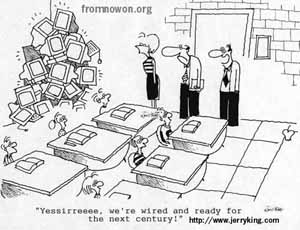Just in Time Technology
|
|
| Vol 12|No 2|October|2002 | |
|
Please feel free to e-mail this article to a friend, a principal, a parent, a colleague, a teacher librarian, a college professor, a poet, a magician, a vendor, an artist, a juggler, a student, a news reporter or anyone you think might enjoy it. Other transmissions and duplications not permitted.
(See copyright statement below). Visit the FNO Press Online Store at http://fno.org/fnopress/books.html
More evidence is accumulating to prove the folly of putting the cart before the horse - drop shipping computers on classrooms without first investing in program and professional development.
No Big Surprise These data from MDR should come as no surprise to those who have read the research on change in schools published by Michael Fullan and Larry Cuban. Schools and teachers have a long history of resisting rapidly implemented, top-down change efforts heavily laced with new technologies.
Furthermore, recent research by Hank Becker showed that teachers respond differently to new technologies based on their levels of readiness and their teaching styles. Becker conclusively demonstrated that mere possession of computers in a classroom (market penetration) would not automatically translate into frequent daily usage. He showed that constructivist teachers would let students use classroom computers three times more often than their traditional counterparts even when both teacher types had five networked computers in their classrooms. (click here to go to "Internet Use by Teachers" Web site at University of California Irvine http://www.crito.uci.edu/TLC/FINDINGS/internet-use/startpage.htm) The End of a Marketing Myth - Penetration = Curriculum Integration Despite decades of research that would argue otherwise, profit-motivated groups selling new technologies actually drew a connection between the number of computers per classroom and the level of curriculum integration. See the April, 1999 article in FNO - "Beware of CEOs Bearing Gifts!" To this day, the Star Chart still places a premium on the number of computers.
While we have no reliable evidence that one-to-one computing translates into improved student learning results, the Star Chart lists the following benefits claimed for a "Target Tech" school that has one computer per student:
Source: The CEO Forum on Education & Technology While this fallacy (penetration = integration) was clear to some educators back in 1999, the nation was swept up in a technology bandwagon that suggested almost anything was possible. These are more sober times, as we have paid the price of speculation and wishful thinking in our own pension funds and investments, seeing equity disappear when the false accounting and inflated prospects of the 1990s were suddenly uncovered. The actual wording of the MDR press release is curious, given the disappointing level of teacher usage.
Teacher Proficiency Stalls MDR reports that the U.S. has been spending some $5 billion annually to equip classrooms while teacher ability and usage remains a serious problem:
This does not sound like an embrace to me!
It Might be even Worse When I looked more carefully at the methodology behind the MDR report, it seemed likely that the true state of affairs in U.S. schools may be even worse than these data indicate. To the credit of MDR, there is a whole chapter in the full report devoted to methodology, and the authors of the report are actually named. MDR's comments about technology use and the skill levels of teachers are based upon a survey sent to each of 4000 schools. One person is asked to estimate how often teachers use technology and what percentage of the teachers fall into each skill category. MDR telephones in order to figure out the most knowledgable person to answer their questions. They do not automatically send the survey to the principal. Survey experts always warn about the "socially desirable response" as a problem. If the survey is filled out by the leader of the school or a program, there is a tendency to provide a rosy picture of what is happening in the building. Just how would someone determine technology usage and skill levels in a building without data from surveys and other assessment instruments? There is some possibility that the MDR data, damning as it is, is actually more positive than the true situation. Suggested Changes in Methodology We need more reports and more data to help us plan how to implement these new technologies wisely. MDR's reports make a major contribution to the field. The value and validity of their annual report might be enhanced by considering several of the following changes: 1) Create a representative national sample of 200-400 schools from which good samples of classroom teachers are asked a range of questions about types of use. 2) Ask more pointed questions about types of learning activities. It is too crude a measure to ask if teachers use the technologies for instruction daily. There are many wasteful uses of technologies like powerpointlessness that should not be counted as achievements. Nor is it meaningful to ask if teachers use the Internet or ask students to use the Internet, as there are many poor uses of the Internet. Mere usage proves nothing. We need to know if the usage is standards-based, valuable and effective. 3) Don't rely on a single respondent. We will not learn what is happening in schools by e-mailing surveys to a single leader and asking that person to describe technology patterns in a school unless we require that descriptive judgments be anchored in data. "How do you know?" should follow each question. Hunch? Guess? Survey data? Personal observations? |
|
Back to October Cover
Credits: The photographs were shot by Jamie McKenzie. |
 From Now On
From Now On
